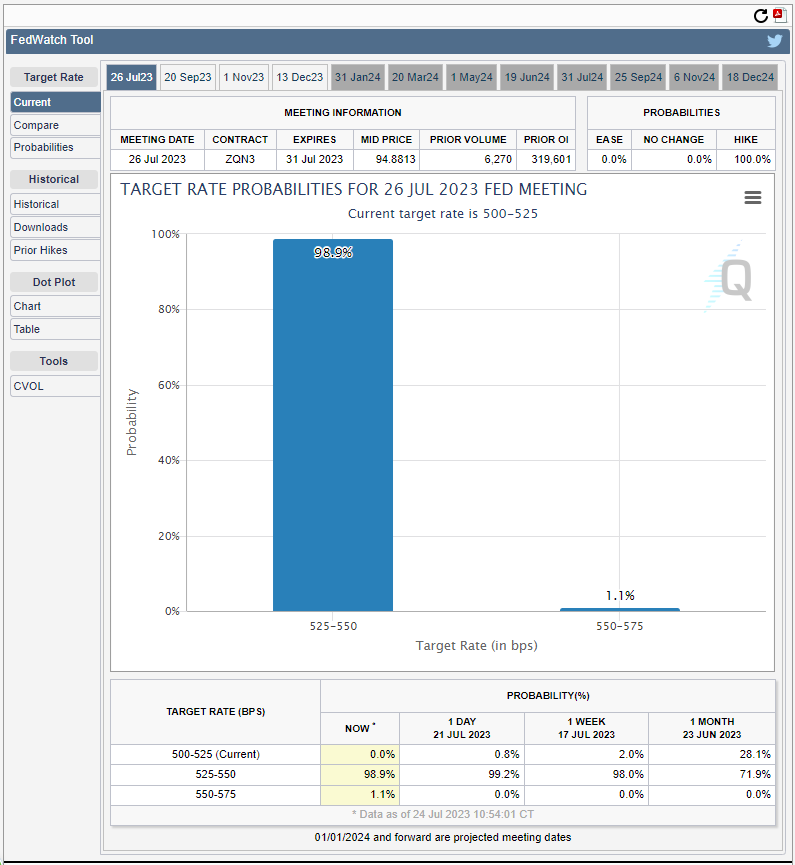Oil prices surge: Analysis pre-Federal Reserve’s decision
|
The global oil market has seen significant moves recently. This article will tell the reasons behind the surge in oil prices.
Production cuts and economic support
The oil market experienced a boost, primarily due to production cuts from major players in the Organization of the Petroleum Exporting Countries and their allies (OPEP+), notably Saudi Arabia and Russia. These reductions, combined with potential economic support from China, have played a pivotal role in the upward trend of oil prices.
Russia's commitment to reducing its exports by approximately 400,000 barrels per day in July and 500,000 barrels per day in August further solidifies the market's confidence in the upward trajectory of crude prices.
WTI Oil peaks
U.S. West Texas Intermediate (WTI) oil prices concluded at their highest in three months, reinforcing the market's belief in Saudi Arabia and Russia's commitment to volume reductions.
Saudi Arabia's announcement in June about its intention to cut production by one million barrels per day in July and August, coupled with Russia's promise to reduce its exports by 500,000 barrels per day next month, has significantly influenced this trend.
Caution ahead of the Fed meeting – CME FedWatch tool
Despite the bullish trend, the oil market's momentum seemed to wane as it approached the Federal Reserve's meeting, which holds significant implications for the global economy (see below chart on probabilities of an interest rate hike).
The probability of a Fed rate hike at this week's FOMC is close to 100%. The US Federal Reserve should therefore increase its rates by 25 basis points to 5.25-5.50%.
In conclusion, while voluntary production cuts by major global producers like Saudi Arabia and Russia have bolstered oil prices, concerns about China's economic slowdown and its impact on oil demand remain. The market's focus has now shifted to the Federal Reserve and the European Central Bank's monetary policy decisions, which are expected to influence global economic optimism and, consequently, oil demand forecasts.
As the global oil market continues to evolve, several questions arise:
How will the decisions of the Federal Reserve and the European Central Bank impact the future trajectory of oil prices?
With the ongoing economic challenges in China, what measures will Beijing introduce to stabilize its economy, and how will these actions influence global oil demand?
Share your thoughts and insights in the comments below.
Chart: US Dollar Currency Index (DXY/USDX)
US Dollar Currency Index – CFD
Chart: Energy Futures (CL; NG; RB; HO)
WTI Crude Oil (CL); Natural Gas (NG); RBOB Gasoline (RB); Heating Oil (HO) – Continuous Futures contracts (4H charts)
Want free follow-ups to the above article and details not available to 99%+ investors? Sign up to our free newsletter today!
Information on these pages contains forward-looking statements that involve risks and uncertainties. Markets and instruments profiled on this page are for informational purposes only and should not in any way come across as a recommendation to buy or sell in these assets. You should do your own thorough research before making any investment decisions. FXStreet does not in any way guarantee that this information is free from mistakes, errors, or material misstatements. It also does not guarantee that this information is of a timely nature. Investing in Open Markets involves a great deal of risk, including the loss of all or a portion of your investment, as well as emotional distress. All risks, losses and costs associated with investing, including total loss of principal, are your responsibility. The views and opinions expressed in this article are those of the authors and do not necessarily reflect the official policy or position of FXStreet nor its advertisers.
